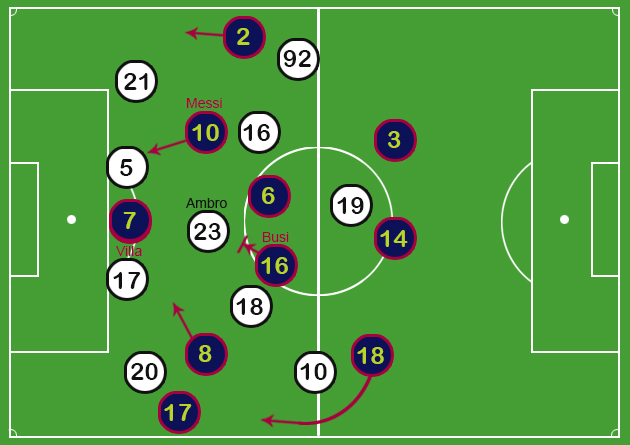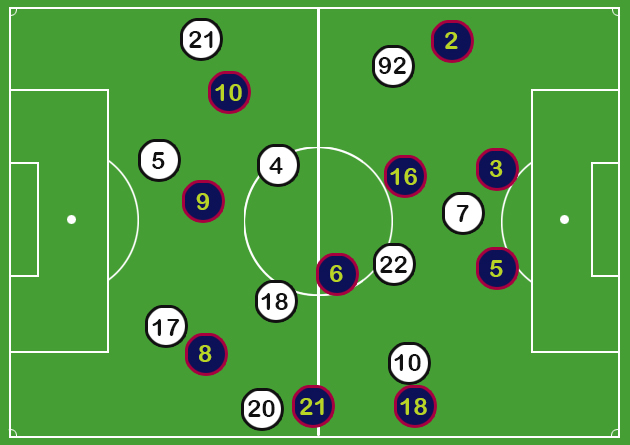 Gonzalo Arroyo Moreno/Getty Images
Gonzalo Arroyo Moreno/Getty Images
Despite holding a 2-0 aggregate lead, the Serie A side weren't able to hold on, and Lionel Messi's opener inside the opening seven minutes really put els Blaugrana on the front foot.
The match was a tactical gold mine, and it's difficult to know where to start.
Formations

Villa as a No. 9
It became immediately evident upon kickoff that Messi was no longer the striking threat.
He dropped into a free role and Villa occupied the centre-backs' attention, allowing Messi to unshackle himself from Philippe Mexes and Cristian Zapata.
This gave Messi two or three players to beat rather than five, and in particular one "bank" of players to breach rather than two.
This seperation allowed him to drop off and play in the areas he wanted to without making Barcelona a truly strikerless outfit—Villa provided a constant presence, and even if he wasn't used too often, the very fact that he was there changed everything for Milan.
His presence meant Massimo Ambrosini could not set up his triple midfield anchor as deep as he wanted, and Messi's drifting did a good job of drawing Milan's midfield up the pitch.
Touchline width
The next change Jordi Roura made was to introduce true width. It's something I touched on a few weeks ago in the aftermath of the 2-0 loss, and it was absolutely crucial for Barca to succeed.
Pedro was deployed on the left side of midfield (shirt No. 17), while Dani Alves played as wide as he could on the right-hand side (shirt No. 2).
This, in addition to Messi's vague presence on the right and Andres Iniesta's on the left, meant that Riccardo Montolivo and Mathieu Flamini—the outside midfielders in the trio—were naturally pulled out to help close down.
The pitch at the Camp Nou is much wider than it is at the San Siro. In dragging these two players just two or three yards out respectively, Xavi and Sergio Busquets were able to isolate Ambrosini in the middle and destroy him with creativity and accurate passing.
These small holes that were created were all Barca needed to play intricate one-two passes. These holes were absent at the San Siro due to a lack of width, and it was this gap that allowed Messi his first goal.
Turnovers
Busquets, tactically speaking, was the Man of the Match. He was integral to the success of Barca and did more in a subtle manner than anyone else.
He was absolutely on his game and was there every time Milan chanced dribbling out of defence with the ball or tried to be too cute. He cut out pass after pass. But it was where he did his work that was so important.
He created turnovers inside Milan's half several times, and with the Rossoneri players moving out of their defensive positions to create passing options, they were caught off-guard.
The second goal was a product of robbing Ambrosini, passing it past him and finding Messi—unmarked, as there was no midfield anchor in place—to fire home.
Changes
Massimiliano Allegri made several changes throughout the game in an effort to get his side back in it.
 Milan come out, play 4-2-4. Barca revert to a lopsided 4-3-3
Milan come out, play 4-2-4. Barca revert to a lopsided 4-3-3
Throwing Robinho on up front was just bizarre, and in truth the Brazilian looked like he'd stumbled upon the Camp Nou in full kit by accident. By the time Bojan got on Milan were practically 4-2-4.
Ignazio Abate, given a free run forward when the score was 3-0, was instrumental in dragging Milan up the pitch and looked a real threat down the right.
There were some flaky moments, but Barca sealed it with a beauty.
Conclusion
There were three key factors in Barca's win: The width provided by Pedro and Alves, the turnovers Busquets created in Milan's own half and the presence of Villa in the No. 9 role.
Do Barca have a plan B? Yeah, they do, it's called playing with an actual striker.
Jordi Roura has faced a lot of questioning over the last three weeks—myself not excluded from that—but he was back with a bang. How much of that was to do with Tito Vilanova we're not sure, but the team selection, tactics and motivation was spot on.
One feels for Milan, who will go home heartbroken. But this was, simply put, sublime from Barca.